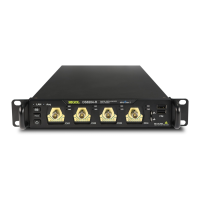
Do you have a question about the Rigol DS8000-R Series and is the answer not in the manual?
| Brand | Rigol |
|---|---|
| Model | DS8000-R Series |
| Category | Test Equipment |
| Language | English |
Important notices regarding product specifications, manual information, and liability.
Information on how to contact RIGOL for support and inquiries.
Essential safety precautions to avoid personal injury and instrument damage.
Guidelines for proper grounding and using the correct power cord.
Instructions for correct probe connection and observing terminal ratings.
Explanation of WARNING and CAUTION notices within the manual.
Definitions of safety terms and explanation of product safety symbols.
Classification of measurement categories (I, II, III, IV) for safety.
Guidelines for ensuring adequate ventilation to prevent overheating.
Operating conditions for temperature, humidity, and altitude.
Instructions for maintaining the instrument's cleanliness and condition.
Information regarding product compliance with environmental directives.
Key features and capabilities of the DS8000-R series oscilloscopes.
Outline of the manual's chapters and main topics.
Steps for inspecting packaging, instrument, and accessories upon receipt.
Instructions for connecting power, display, and performing turn-on checkout.
Procedures for connecting probes and performing initial function checks.
Steps to properly compensate probes for accurate measurements.
Description of the front and rear panel connectors and indicators.
Explanation of the graphical user interface elements and operating status.
Instructions for setting up LAN and USB connections for data transfer and control.
Guide to accessing and using the oscilloscope's integrated help.
Procedures for checking installed options and installing new ones.
Steps to enable, disable, and adjust vertical scale and offset for channels.
Configuration of channel coupling modes and bandwidth limit settings.
Setting probe attenuation and input impedance for accurate measurements.
Procedures for setting horizontal time base and adjusting waveform position.
Guide to enabling and using the delayed sweep for waveform detail analysis.
Explanation of different timebase modes and their applications.
Details on different acquisition modes for waveform capture.
Selecting trigger sources (channels, EXT, AC Line) and setting trigger levels.
Understanding trigger modes (Auto, Normal, Single) and coupling options.
List of available trigger types including Edge, Pulse, Slope, and serial protocols.
Performing mathematical operations on waveforms like addition, subtraction, and FFT.
Utilizing auto measurement for quick analysis of waveform parameters.
Using cursors (X, Y) for manual measurement of waveform values.
Using the built-in DVM for 3-digit voltage measurements.
Utilizing the frequency counter for measuring frequency, period, and events.
Testing AC input line quality and analyzing power parameters.
Analyzing DC power supply ripple quantity and measuring ripple parameters.
Steps to enable, select type, source, and measurement items for histogram analysis.
Adjusting histogram bar graph height and window range for analysis.
Enabling statistical display and resetting histogram data.
Configuring eye diagram analysis including source, threshold, and clock recovery.
Performing jitter analysis including source, threshold, and measurement items.
Configuring parallel bus decoding, including clock and bus settings.
Setting up RS232 decoding parameters like baud rate, source, and data package.
Configuring I2C bus decoding, including source, threshold, and display settings.
Setting up SPI bus decoding parameters like mode, source, and data settings.
Configuring LIN bus decoding, including source, signal type, and display settings.
Setting up CAN bus decoding parameters like source, signal type, and display settings.
Configuring FlexRay bus decoding, including source, signal rate, and display settings.
Setting up I2S bus decoding parameters like source, bus settings, and display.
Configuring 1553B bus decoding, including data source, threshold, and display settings.
Steps to enable reference function, select channel and source.
Adjusting vertical scale/offset and saving reference waveforms to memory.
Procedures for clearing, resetting, and exporting reference waveform data.
Customizing reference waveform display with colors and labels.
Instructions for enabling, starting, and stopping the pass/fail test function.
Steps to define, save, and load test masks for pass/fail criteria.
Setting output forms, error actions, and displaying test result statistics.
Basic settings for waveform recording, playback, and current frame selection.
Parameters for waveform recording interval, number of frames, and beeper settings.
Settings for playback mode, sequence, interval, and frame selection.
Enabling search and selecting search types and parameters.
Copying trigger settings and opening/closing the mark table.
Using navigation keys and saving event mark data.
Setting waveform display mode (Vector, Dots) and persistence time.
Configuring waveform intensity, screen grid, and grid brightness.
Enabling color grade display and waveform freeze function.
Setting parameters for Sine, Square, Ramp, Pulse, DC, Noise waveforms.
Configuring amplitude, frequency, and frequency-shift keying modulation.
Configuring sweep modes (Linear, Log, Step) and parameters.
Setting burst type (N Cycle, Infinite) and trigger sources.
Understanding storage system, types (Image, Wave, Setup), and file formats.
Saving and loading oscilloscope setups and reference waveforms to internal memory.
Saving and loading files to/from external USB storage devices.
Managing files and folders on storage devices, including create, delete, copy.
Configuring remote interfaces like LAN, USB, and GPIB for PC communication.
Configuring system settings such as beeper, language, and power-on behavior.
Performing self-calibration and configuring auto setup parameters.
Instructions for connecting and installing drivers for USB remote control.
Configuring network parameters and searching for resources for LAN control.
Steps for connecting, installing drivers, and searching for GPIB control.
Solutions for issues like a dark screen or ladder-like waveform display.
Troubleshooting steps for USB storage device recognition problems.
List of available accessories, options, and their order numbers.
Details regarding the product warranty terms and conditions.